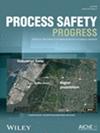An integrated system theoretic process analysis with multilevel flow modeling for the identification of cyber‐physical hazards in a process industry
IF 1
4区 工程技术
Q4 ENGINEERING, CHEMICAL
引用次数: 0
Abstract
The deep integration of information technology and process industry production systems makes system failure increasingly multi‐source and multi‐scale. In contrast to conventional hazard methods, system theoretic process analysis (STPA) can analyze the hazards in system control processes from the perspective of interactions among the system components. Theoretically, this method offers advantages that are better suited for modern production systems. However, as of now, the integration between STPA and process industrial production systems is still lacking. To address this issue, this study improved the original STPA method. First, we propose the “5 flows” concept for the process industrial cyber‐physical systems. The systems are described using multilevel flow modeling (MFM). This leads to the development of the MSTPA method, which is specifically designed to analyze the cyber‐physical hazards in process industrial production systems. Subsequently, the cyber‐physical hazards of a fluidized‐bed catalytic cracking unit are analyzed in detail using the MSTPA method as an example. The results show that MSTPA can identify cyber‐physical hazards in multiple dimensions. It is proved that, compared with the original STPA and traditional hazard methods, the MSTPA method can better identify cyber‐physical hazards in process industrial production systems.综合系统理论流程分析与多级流程建模,用于识别流程工业中的网络物理危害
信息技术与流程工业生产系统的深度融合,使得系统故障越来越具有多源性和多尺度性。与传统的危害分析方法相比,系统理论过程分析法(STPA)可以从系统各组成部分之间相互作用的角度来分析系统控制过程中的危害。从理论上讲,这种方法具有更适合现代生产系统的优势。然而,到目前为止,STPA 与流程工业生产系统之间仍缺乏整合。针对这一问题,本研究对原有的 STPA 方法进行了改进。首先,我们提出了流程工业网络物理系统的 "5 流 "概念。使用多级流建模(MFM)对系统进行描述。由此开发出 MSTPA 方法,该方法专门用于分析流程工业生产系统中的网络物理危害。随后,以流化床催化裂化装置为例,详细分析了该装置的网络物理危害。结果表明,MSTPA 可以从多个维度识别网络物理危害。事实证明,与原有的 STPA 和传统危险方法相比,MSTPA 方法能更好地识别流程工业生产系统中的网络物理危险。
本文章由计算机程序翻译,如有差异,请以英文原文为准。
求助全文
约1分钟内获得全文
求助全文
来源期刊

Process Safety Progress
工程技术-工程:化工
CiteScore
2.20
自引率
10.00%
发文量
99
审稿时长
6-12 weeks
期刊介绍:
Process Safety Progress covers process safety for engineering professionals. It addresses such topics as incident investigations/case histories, hazardous chemicals management, hazardous leaks prevention, risk assessment, process hazards evaluation, industrial hygiene, fire and explosion analysis, preventive maintenance, vapor cloud dispersion, and regulatory compliance, training, education, and other areas in process safety and loss prevention, including emerging concerns like plant and/or process security. Papers from the annual Loss Prevention Symposium and other AIChE safety conferences are automatically considered for publication, but unsolicited papers, particularly those addressing process safety issues in emerging technologies and industries are encouraged and evaluated equally.
 求助内容:
求助内容: 应助结果提醒方式:
应助结果提醒方式:


